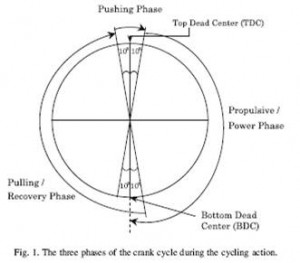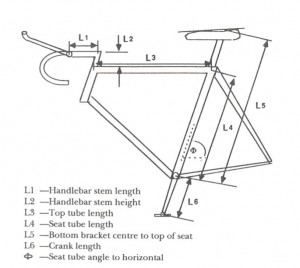Do you ride for fitness, competition, mountain biking, triathlon, off-road racing, or just for the Coffee shop at the end of the ride?
Let’s consider some facts about cycling:
If you take 2.5 hours to cycle race 100km
Your average cadence is 90rpm
This means that as you cross the finish line, you will be making pedal stroke number 64,800!
That’s a whole lot of repeated movements and muscle contractions that can easily result in soft tissue or joint overload.
The three main reasons why overuse injuries occur in cyclists are:
- poor biomechanics (ie. the way your body moves and muscles contract, including your core/trunk stability)
- poor bike mechanics (not the people who clean bikes- but the way your bike handles)
- poor cycling technique/training habits
Biomechanics of Cycling and Bike Position
The benefit to cycling as a sport is that it is non-weightbearing so forces through joints and tissues are generally less than many weight-bearing sports. Additionally, muscle contractions are concentric. This means that the muscle length shortens as the muscle contracts (as opposed to eccentric contractions where the muscle is lengthening as it contract and which is the more muscle-damaging contractions). This is why, in general, you will get less muscle pain and soreness from cycling as opposed to running (especially downhill or acceleration/deceleration running).  Power output through-out the pedal stroke is not equal. At different points through-out the pedal stroke, different muscles are in better positions to provide optimal power output:
Power output through-out the pedal stroke is not equal. At different points through-out the pedal stroke, different muscles are in better positions to provide optimal power output:
- Peak pedal force is at 100o
- For efficiency, there should be a smooth transition of power from power phase to recovery phase which means “pulling” across the bottom dead centre (BDC) and “pushing” across top dead centre (TDC)
There are 3 points of contact between your body and bike that act as bases of support and therefore need to be ‘stable’ (or in the optimal position to help power output be delivered to the pedals to propel you forwards): pelvis on saddle, foot in shoe on pedal, and hands on handlebars. Your abdominal, low back and pelvic stability is critical for ensuring your pelvis remains still on the saddle and that you are not excessively using your arms to attempt to stabilise your body. Your foot must be in the optimal position on the pedal to ensure delivery of the force your body generates is delivered to the bike. And your upper limb should be helping stabilise your trunk only (except in mountain biking and track racing). Having the correct position on the body is essential for maximising power output using the correct muscles and having a stable body position on the bike.
Bike Mechanics
Minor faults in the cranks, pedals or axles can cause overuse injury and faulty brakes can result in impact injury. Faults commonly happen after a crash when slight twisting/mal-alignment of equipment occurs. To reduce your risk of injury from your Bike Mechanics, get into the habit of regularly looking over your bike and checking bolts, and make sure you get a regular bike service, just like you would do with your car.
Cycling Technique and Training
Technique is more difficult to check as it usually needs input from a good coach or sports professional and usually requires a Video of you riding (in the Bike Fit performed at GCPSH, we video you riding on your bike and watch it is slow motion to check technique) Poor technique includes: -incorrect foot position on the pedals -poor leg position & thigh/shank pathway through the pedal stroke -sitting skewed on the saddle -being too stretched out -pulling-up through the up-stroke phase. This should be passive and good technique involves pushing through TDC and pulling through BDC. Poor training habits include: -Excessive hill training -Riding big gears at low rpm -Inadequate cold weather protection -Riding in groups on your time-trial bars as this means your hands are not close to your brakes -Never doing any training of, or improving, your bike handling skills -Wearing headphones while riding on the road so you have less awareness of traffic
The keys to minimising your risk of injury as a cyclist?
- Ensure you are riding the correct size bike frame
- Riding the correct frame will allow you to have a correct Bike Fit and get this done by someone who cares and fits you on the bike
- Make sure you perform some regular self-maintenance exercises to reduce muscle tone/tension that will develop from repeated contractions, for example get a regular massage from a professional therapists that understands your needs and goals as a cyclist and can help maintain healthy tissue tension.
- Make sure you have flexibility where you it for good cycling position and technique. You ideally need good hamstring, calf and ankle bend flexibility and low back and hip mobility.
- Work on your bike handling skills and be careful in road traffic
How will a Bike Fit help?
 It minimises your risk of injury by putting joints and muscles in optimal positions
It minimises your risk of injury by putting joints and muscles in optimal positions- It improves your riding efficiency and/or speed for performance
- It improves your comfort on the bike and enjoyment of riding
What should be taken into consideration in your Bike Fit?
1.Your purpose and/or goals of riding
There are differences in bike set-up depending on what type of bike you are riding and what level of performance you want. For example, if you are time trialling you will need to be as physically aerodynamic as possible to reduce wind drag resistance slowing you down, which may mean sacrificing a little bit of comfort. If you are mountain biking you will need to have optimal use of your upper limb for helping to stabilise and control the bike in different types of terrain and seat height may be a little lower so that it is easy to get a foot out and to the ground for support. Coffee shop hybrid riders are all about comfort so having a nice comfy saddle and being a little more upright is usually the go!
2. Your injury history 85% of recreational cyclists report having at least 1 injury that appears cycling-related. The most common injury site is the knee, then the neck and low back (Wilber et al, 1995). Body area’s that become painful to ride need to be reviewed on and off the bike to establish what the cause is for the pain and whether it is bike-position-related, or whether addition flexibility or strength exercises need to be performed off the bike to ensure your limbs are supported in the best position when on the bike.
3. Your individual flexibility (identifying those area’s of flexibility needed to ride in an optimal position for technique and comfort
4. The type of Bike you are riding (ie. Road, Time-trial, Mountain Bike, Track, Hybrid, other)
Some common reasons you definitely need to get your Bike Fit checked asap:
1. Pain in your back, neck or shoulder blades
2. Sore hands or tingling in your hands
3. Hot/numb feet
4. Saddle discomfort (including one-sided pressure sores)
5. Knee pain
6. Experiencing a lack of power or being uncomfortable to ride longer periods
7. Poor handling
8. Breathing restrictions
9. Experiencing regular tissue injury
If you are changing your bike position due to an injury, choose a professional who has knowledge in both bike fit and injury management- a physio can fit your body to the bike as much as the bike to your body!
As a Sports Physio who does Bike Fit’s, I prefer working with amateur athletes who are, or have been, experiencing injury or pain as it becomes an interesting challenge figuring out how to optimise your biomechanics while minimising tissue stress. In the past I have completed Bike Fit’s for clients with total hip replacements, or Osteoathritic hips that have limited hip range of movement, cartilage loss in the knee joint, post-collar bone fracture where significant shoulder weakness is present, recurrent low back pain and carpal tunnel symptoms at the wrist.
A Bike Fit at GCPSH will:
-Assess your flexibility and any body area’s of concern,
-Video review you if necessary
-Check and re-check your bike position, modify where necessary and advise on other changes that need to be made to your bike
-Give you Recommendations on stretches, exercises, self-maintenance techniques, technique changes to be made and any other follow-up required.
If you have any questions about your Bike Position or where you can go to improve your technique and bike handling skills, email us on info@mygcphysio.com.au
Happy and Safe Cycling until then! Britt Caling, APA Sports & Exercise Physio

































